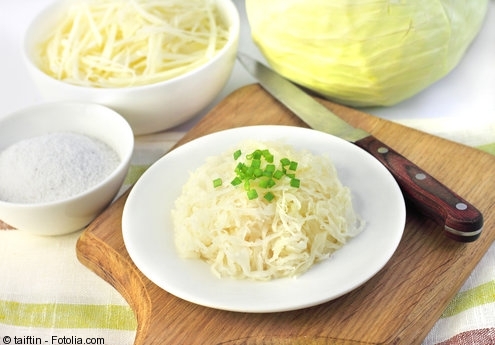
Do you have a garden full of cabbages? Making sauerkraut may help preserve some of your cabbages to avoid wasting them. Below are the steps to make sauerkraut.
Ingredients
- 25 lbs. of cabbage or 5-6 heads
- ¾ cup of pickling or kosher salt
- A fermentation crock
- Choosing which cabbage to ferment maybe a hard task. Look for firm heads of cabbage to achieve the best possible result. It is best to ferment the cabbages between 24-48 hours after harvesting them.
- Wash the each head of cabbage in cold running water. Take off the outer leaves and put them aside.
- Cut and slice the cabbages very thinly, you may use a food processor for easier work; it can also shred the cabbages finer and more uniformly than using a knife.
- Put the shredded cabbages in the fermentation crock and add 3 tablespoons of pickling or kosher salt evenly. Mix them well so that the salt is evenly distributed among the shredded cabbage. Pack them tightly until the cabbages’ water draw out.
- Repeat all the steps for the rest of the cabbages. Be sure to mix and fit them evenly in the fermentation crock. Test to see if the water level is just a bit above the cabbage line. If it is not, add cooled and boiled brine (per quart of water, add 1 tablespoon of salt)
- Add some weight onto the container and cover with a clean towel.
- For best results, store the container between the temperatures of 70ºF and 75ºF. Within this range of temperature, the sauerkraut will fully ferment in about 3-4 weeks. If you place it at 60ºF to 65ºF, it might take 5 or even 6 weeks to be fully fermented. If you place it any lower than 60ºF, the cabbage might not ferment. Placing it higher than 75ºF however, the sauerkraut may become too soft.
- After making sauerkraut, you may need to store it for preservation and future use. You can use a hot packing or a raw packing method:
Hot Packing – Place the sauerkraut in a large kettle. Boil slowly while stirring it consistently. Stop when the sauerkraut is about to boil as it may destroy the texture. Remove it from heat and transfer them inside jars firmly but leave a half-inch headspace.
Raw Packing – Without heating and boiling the sauerkraut, just fill the jars with it and also leave a half-inch headspace. You can now refrigerate the jars and it can be stored there for months on end.
Additional Tips:
- Remember to clean the cabbages thoroughly. If you see a worm inside one, just discard it to avoid problems when fermenting. Sterilize all the tools you will be using, you don’t want to have food poisoning when eating the sauerkraut.
- While making sauerkraut, some scum may appear. Remove them entirely before eating or tasting the sauerkraut.
Always protect your container from bugs or insects. These may contaminate the sauerkraut and can cause health problems. Cover the lid with something that bugs cannot pass through.
